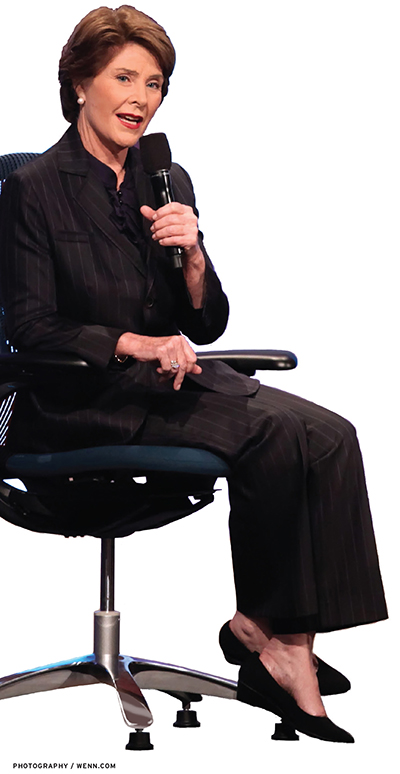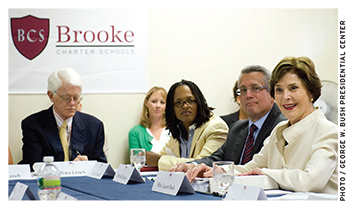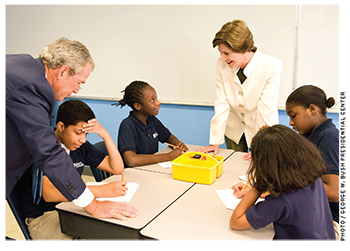There is nothing like a presidential whirl. Bomb-sniffing dogs, Secret Service agents, layers of aides and VIPs. It is intimidating and exhilarating at the same time.
And so it is quite remarkable to see that whirl in a school, as I did last summer in Boston when former president and first lady George W. and Laura Bush visited one of the Brooke Charter Schools. There is also nothing like a roomful of 1st graders, blissfully unaware of who exactly these two big people are or why their classroom is suddenly filled with a couple dozen adults peering at them as they sing “This Land Is Your Land” and wave American flags. Indeed, six-year-olds have a way of sucking all the trappings of celebrity right out of a room, if not out of the celebrities themselves: the Bushes seemed as relaxed and cheerful as any regular person would be. Laura Bush, former teacher and librarian, was a natural.
 Walking in and out of classrooms in her stylish ivory jacket, Mrs. Bush looked right at home. “Are you all having fun?” she asked a group of 5th graders in Julie Gilbody’s math and science classroom. (“Yeah!” was the cry.) “So nice to meet you. This is very exciting.”
Walking in and out of classrooms in her stylish ivory jacket, Mrs. Bush looked right at home. “Are you all having fun?” she asked a group of 5th graders in Julie Gilbody’s math and science classroom. (“Yeah!” was the cry.) “So nice to meet you. This is very exciting.”
She walked between the desks, asking students what they were working on, what they wanted to do when they grew up, what their goals were. She read Seuss to 1st graders (after answering tough questions about life in the White House), encouraging the kids “to read for 30 minutes every day at home.” And then, “Do you want to hear about our animals?” The class erupted. “We have two dogs and a little kitten. He used to catch rabbits, but we tamed him and now he eats cat food.” The kids were transfixed.
After visiting the classrooms, the former first lady agreed to chat with Education Next about the new George W. Bush Institute and its ambitious plans to continue to build on the Bush education-reform legacy.
Education Is the First Priority
“It’s a full-time job,” says Mrs. Bush, sitting at a student desk in a classroom (empty, except for several aides and a watchful Secret Service agent). “It’s what we’ll do for the rest of our lives through the policy institute.” The Bush Policy Institute will be part of the Bush Presidential Library, set to open in the spring of 2013. The Dallas Morning News described the three-year-old institute as “advanc[ing] a robust policy agenda,” most of it, so far, out of public view. The Bushes have made several trips to Africa, for instance, promoting HIV and cancer prevention programs. Global health is one of the institute’s four major “areas of engagement,” the other three being human freedom, economic growth, and education reform.
“These are the core policy areas that were the most important to us when George was president,” says Mrs. Bush. “They are just important to us. They’re just really American values. They’re not just for one party or the other, but in fact they’re for all of us.”
While keeping a low profile and staying out of the No Child Left Behind (NCLB) debate, the Bushes have built an education think tank that is pursuing an ambitious education-policy agenda, focusing on school leadership, middle school improvement, and standards and accountability. One of the institute’s first education initiatives was the Alliance to Reform Education Leadership (AREL), a nationwide network of principal preparation programs with a mandate, as a 2010 press release put it, “to transform the way school districts identify, recruit, prepare, empower, and evaluate their leaders.”
“Our very first fellow at the institute was an education fellow,” says Mrs. Bush. “Dr. Jim Guthrie brought us the idea of principal recruiting and training and working with principal training groups around the country…. We wanted education to be the first of the four policy areas that we worked on because we think it’s so important. There is an urgency about what we’re doing—there should always be an urgency.”
Education Roots
 It is clear where Mrs. Bush came by her sense of urgency for, and expertise on, the subject: she wanted to be a teacher at age eight. “My 2nd-grade teacher, Miss Gnagy,” she explains. “I wanted to be just like her.” And 14 years later, Laura Welch graduated from Southern Methodist University (SMU) with a degree in education and became a 2nd-grade teacher in an inner-city school in Dallas. She also mentions Dr. Harryette Ehrhardt, her professor of children’s literature at SMU, as one of her education heroes. Ehrhardt went on to become a liberal Democratic state representative at the same time as Laura’s conservative Republican husband became Texas governor. But to this day, says Mrs. Bush, she still talks about, and with, Ehrhardt. “I visited her for lunch just a couple of weeks ago.”
It is clear where Mrs. Bush came by her sense of urgency for, and expertise on, the subject: she wanted to be a teacher at age eight. “My 2nd-grade teacher, Miss Gnagy,” she explains. “I wanted to be just like her.” And 14 years later, Laura Welch graduated from Southern Methodist University (SMU) with a degree in education and became a 2nd-grade teacher in an inner-city school in Dallas. She also mentions Dr. Harryette Ehrhardt, her professor of children’s literature at SMU, as one of her education heroes. Ehrhardt went on to become a liberal Democratic state representative at the same time as Laura’s conservative Republican husband became Texas governor. But to this day, says Mrs. Bush, she still talks about, and with, Ehrhardt. “I visited her for lunch just a couple of weeks ago.”
After becoming first lady of Texas in 1995, Mrs. Bush spearheaded initiatives on early childhood education, which she continued to do as first lady of the country, while expanding her education interests to include serving as the ambassador for the UN Literacy Decade, visiting schools and promoting girls’ education through the Africa Education Initiative, making seven trips to Africa and three trips to Afghanistan.
The Bushes are a true education couple. Her husband’s sense of urgency about education, Mrs. Bush says, came from his tour of duty as governor. “George got interested in education policy when he was campaigning for the office. At the time, he said education is to a governor what defense is to a president. In a state, education is the most important issue. You’ve got to make sure that every single child is educated…. He ran for governor on that issue, on the issue of education, and then he ran for president on the same issue.”
So, says Mrs. Bush, it was natural for them to establish a policy institute devoted to education once the presidency was behind them. “We had conversations over the dinner table about it.” And she notes that having been president gives one “a convening power” that regular folks don’t have. “Right after we moved home, we flew in a whole lot of people from our administration. We met over two days to talk about these four policy areas that were the most important when he was president. We could stay involved with policy, but stay out of politics. We chose the four policy areas that were the most important to us, and education was the first one we chose.”
Too Many Goals Means No Goals
 It is clear in speaking with Laura Bush, even if one doesn’t know the history, that she is no token education spokesperson; she knows the territory. I ask how the decision to focus on education leadership was made.
It is clear in speaking with Laura Bush, even if one doesn’t know the history, that she is no token education spokesperson; she knows the territory. I ask how the decision to focus on education leadership was made.
“We knew that we would only want to focus on one or two policy issues within each of our four big policy areas. As George said today, sometimes you have so many goals you don’t have any goals. And we don’t have that big of a staff!” The institute currently has 44 full-time employees and 22 part-time fellows.
About the institute’s Middle School Matters initiative, she says, “Middle schools are always left out, and it’s because no one really wants to be around middle school–age kids. I know…. I had two 13-year-old girls once and I know what that was like….”
She smiles, but then quickly talks about the research. “There’s a lot of research, developed in the last decade or so, about how to intervene in middle school to bring kids up to grade level. A lot of people have come to think that middle school is when kids actually ‘drop out.’ They just leave in high school. Middle school’s the last chance that you have to be able to be successful in high school. If you can’t read when you get to middle school, then you won’t be able to succeed in high school.”
Mrs. Bush is equally articulate about “backpack spending” (the institute is sponsoring a project on school-district productivity that includes 20 different researchers’ papers); teacher autonomy (“Obviously, if you are held accountable as the principal of your school and you don’t have the authority to change anything, by either hiring or firing, or setting up another structure that your school district doesn’t allow, then how can you be really accountable?”); and NCLB, which, she says, “was not designed to tell the school districts what to do.” It was up to the states and districts to devise a curriculum, she explains. “It can’t be top down, because if the federal government says, ‘This is what you have to teach for so-and-so,’ then they can say, ‘Oh, well, we did that. We did what you said, but we failed,’ instead of, ‘We came up with the idea and we did it and we failed or we succeeded.’”
Laura Bush is hands-on, and she intends to stay that way. She convenes monthly meetings of the institute staff for regular updates and reads all the papers the institute produces. She cares about education. And it is clear that the Bush Institute will be a major player in the education reform movement in the future.
Peter Meyer is former news editor at Life Magazine and contributing editor at Education Next.
This article appeared in the Spring 2013 issue of Education Next. Suggested citation format:
Meyer, P. (2013). Education Activist Pursues an Ambitious Agenda: A conversation with Laura Bush. Education Next, 13(2), 42-44.


